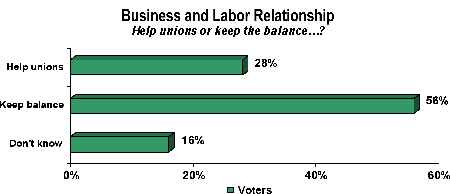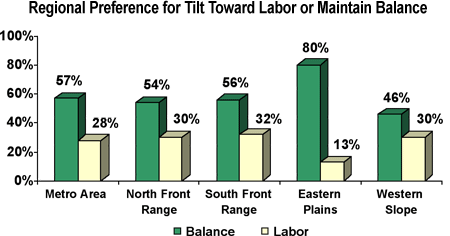|
Ciruli Associates Poll
Third-Annual Citizen's Poll Shows
Colorado Voters Want to Maintain Labor-Business Balance
Analysis by Floyd Ciruli
October 9, 2008
In a new survey by Ciruli Associates, just over one-quarter of voters want to tilt current laws to assist labor unions’ efforts to organize workers. The majority of voters favored the current balance between labor and business.
In a poll conducted for the Economic Development Council of Colorado from September 19-23, 2008, 56 percent of Colorado voters agreed with the statement: “State laws concerning labor unions and organizing workers should stay as they are now. Organizing workers into unions does not need to be made easier. There is a good balance between labor unions and business in Colorado.” Only 28 percent support the alternative presented: “Colorado needs to change its laws to make it easier for unions to organize workers. State laws unduly favor business and restrict labor unions.”

Ciruli Associates, N501, 2008
Question: Next, as I read the following statements, please tell me which statement comes closest to your personal view on the topic and whether it is much closer or only somewhat closer to your personal view. And would you say that the statement is much closer to your personal view or only somewhat closer? [Rotated]
Colorado needs to change its laws to make it easier for unions to organize workers. State laws unduly favor business and restrict labor unions, or State laws concerning labor unions and organizing workers should stay as they are now. Organizing workers into unions does not need to be made easier. There is a good balance between labor unions and business in Colorado.
The Third-Annual Citizens’ Poll was sponsored by the Economic Development Council of Colorado (EDCC), a statewide consortium of local and regional economic development professionals. This marks the third consecutive year of the EDCC’s poll on economic development and government issues. The statewide survey was conducted by Ciruli Associates with 501 randomly selected Colorado voters. The statistical range of error is ±4.4 percentage points.
Regions and Political Parties
The pattern of preference for changing the labor/business relationship shows little variation among the regions of the state, with only the Eastern Plains and Western Slope showing some deviation from the norm.

Ciruli Associates, N501, 2008
Democrats were more inclined to want to help labor’s organizing efforts, but a plurality still prefer the status quo.
|
Party Preference for Tilt Toward Labor
or Maintain Balance
|
|
|
Sample
Total
|
Tilt Toward
Labor
|
Maintain
Balance
|
|
Total
|
|
28%
|
56%
|
|
Democrat
|
38%
|
41%
|
43%
|
|
Unaffiliated
|
21%
|
26%
|
51%
|
|
Republican
|
40%
|
19%
|
70%
|
|
Ciruli Associates, N501, 2008
|
Recent History of Conflict
The high-profile conflict between organized labor and business is a new focus in Colorado elections. Although labor and business often take opposing views on ballot issues and legislation, the seven initiatives (later reduced to three) on the November ballot that directly affect how business and labor operate reflect a dramatic increase in conflict.
Colorado’s periodic labor-management disputes that result in strikes seldom rise to the political drama seen in late September. The last great labor-business battle that made national news and lingered in collective memory for Coloradans was the Coors Brewery vs. Teamsters organizing battles of the 1960s and 1970s.
The current conflict had its origins in the shift of partisan politics in Colorado after the 2006 election when Democrats increased their majorities in both houses of the legislature and Bill Ritter became governor, a circumstance that last happened for the Democrats in 1958 – half a century ago.
With the shift of power came an inclination by Democrats and their labor allies to help union organizing in the state. Beginning with pro-labor legislation early in 2007 through the current ballot fight over right-to-work, the business and labor relationship became center stage in the 2008 election.
|
Brief History of Labor/Business Ballot Conflicts
|
|
Date
|
Action
|
| January 2007 |
Legislature attempts to abolish a second election before compelling workers to join a union or pay fees. Governor vetoes the bill. He claims process was flawed, but avoids an opinion on the substance. |
| November 2007 |
Governor signs executive order creating bargaining partnerships, leading to unionization of state employees. |
| Spring/Summer 2008 |
Small group of business executives and owners place right-to-work on the ballot. Two other initiatives to limit unions in government (ban payroll deductions, and political contributions from sole-source contractors) are also placed on the ballot. |
| Summer 2008 |
Organized labor drafts four ballot initiatives to threaten business with the consequences from the right-to-work measure. Business labels the initiatives “job killers” (no firing without just cause, health care for employees, a safe work place and criminal responsibility). |
| Fall 2008 |
After long and public negotiations, agreement is reached among larger business associations and organized labor to join forces against the right-to-work and other anti-labor initiatives in exchange for organized labor’s withdrawal of its anti-business initiatives. |
Early Ballot Polling
Early polling conducted by the EDCC indicates right-to-work has little support at present, mostly reflecting the public’s lack of desire to shift the balance between business and labor. The two measures to limit government’s involvement with unions are doing slightly better.
The only labor initiative, now withdrawn, that had majority support in late September proposed new rules for criminal responsibility for business executives. Its popularity related more to the Wall Street meltdown than any Colorado controversy.
Labor/Business-related Ballot Issues
(Amendments 53, 55, 56 and 57 Removed From Ballot) |
| Ballot Questions |
Vote
For
|
Vote
Against
|
Don’t
Know
|
Never
Vote on
Amendments
|
| Amendment 53 – Criminal responsibility (withdrawn) |
58%
|
18%
|
19%
|
5%
|
| Amendment 56 – Health insurance for 20 or more employees (withdrawn) |
48%
|
30%
|
17%
|
5%
|
| Amendment 54 – Limit contributions by government contractors |
45%
|
22%
|
28%
|
6%
|
| Amendment 49 – No payroll deduction |
44%
|
33%
|
20%
|
5%
|
| Amendment 57 – Safe workplace for employees (withdrawn) |
41%
|
37%
|
18%
|
4%
|
| Amendment 47 – Right to work |
39%
|
40%
|
17%
|
5%
|
| Amendment 55 – Fired for just cause (withdrawn) |
39%
|
38%
|
18%
|
5%
|
| Ciruli Associates, N501, 2008 |
Question: The following proposals are on the November 2008 election ballot. The description of the proposal is taken from the state election blue book mailed by the state to all voters. Please tell me, as of today, will you definitely vote for the proposal, likely vote for the proposal, likely vote against the proposal or definitely vote against the proposal? [Read in ballot order]
Survey Design
The 501 respondents of the telephone survey were selected from a random sample of Colorado registered voters who regularly vote in presidential-year elections. Voters were then screened to determine their likelihood to vote. Statistical range of accuracy in 19 out of 20 cases is plus or minus 4.4 percentage points for a sample size of 501 – meaning that 95 percent of the time if all voters with telephones in Colorado had been surveyed, the findings would differ from the survey results by no more than plus or minus 4.4 percentage points. Survey results can be affected by other factors, such as question wording and order.
. . . . . . . . . . . .
Ciruli Associates is a non-partisan research firm providing polling, election analysis and political commentary to Colorado and national media organizations since 1976.
[top] [archives] [home] [send this page to a friend]
|